Learn how to make Kombu Dashi, a vegan-friendly Japanese soup stock, at home and enhance your Japanese dishes with umami flavor!
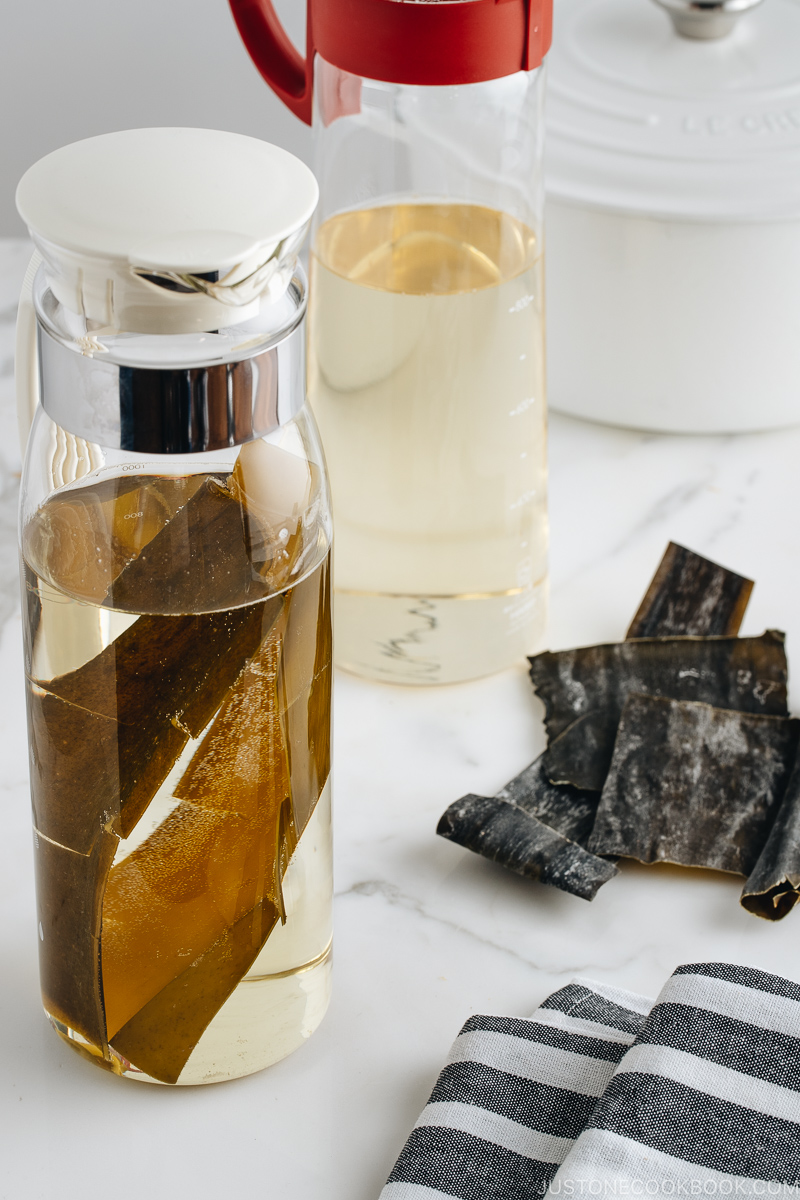
Dashi (Japanese soup stock) is a Japanese soup stock, and it is a fundamental ingredient in many Japanese dishes to create authentic flavor. Today I want to share how to make Kombu Dashi (昆布だし).
What is Kombu Dashi?
Kombu Dashi (昆布だし) is a Japanese soup stock made with kombu (昆布 dried kelp), dried kelp that is used extensively in Japanese, Korean, and Chinese cooking. In Korean, it is referred to as dasima (다시마), and in Chinese as haidai (海带).
Kombu Dashi is vegetarian and vegan and the easiest dashi you can make.
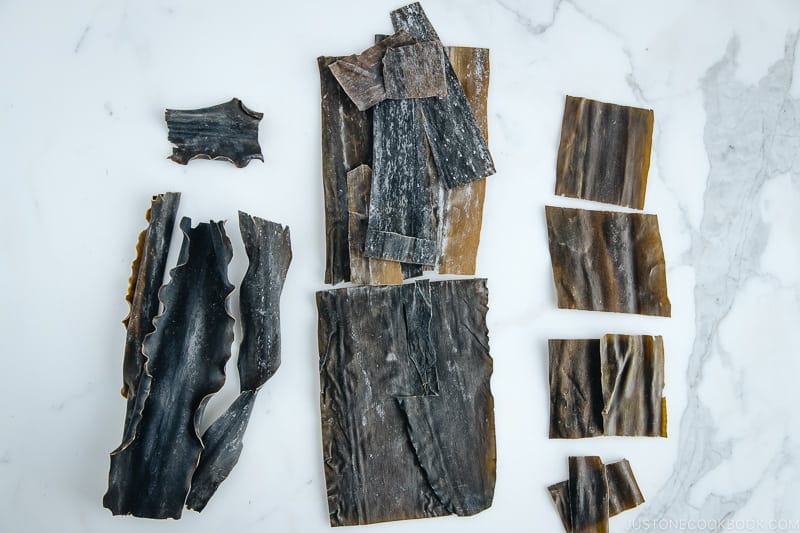
This sea vegetable earns its name as ‘the king of seaweeds’ because it possesses an amazing flavor and nutritional value, unlike any other seaweed. The most noteworthy advantage is its high content of glutamic acid, an amino acid responsible for umami. And umami is what you’re looking for in a dish where it provides a complex, elemental taste.
If you follow a vegetarian/vegan diet or simply want to embrace a more plant-based diet, kombu is an outstanding ingredient to incorporate into your cooking. Besides being a great flavor enhancer and tenderizer, kombu is a powerful, health-promoting food that can make up for certain nutrients that are absent in the diets.
In my pantry kombu page, I discuss different types of kombu and which kombu is good for specific types of food. Please go over the post if you want to know more about how to use kombu for Japanese cooking.
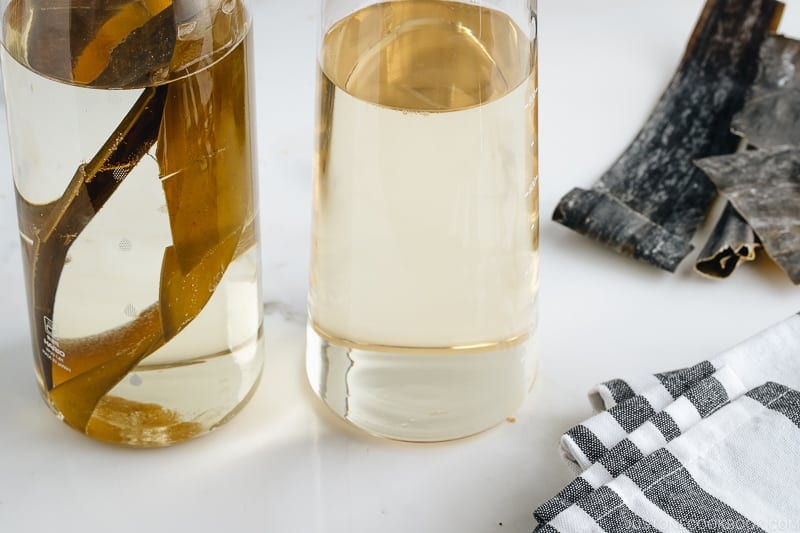
Two Methods in Making Kombu Dashi:
Method 1: Cold Brew
The cold brew or Mizudashi (水出し) method is pretty hands-off. All you need is to put water and 1-2 kombu strips in a large bottle, let steep for 2-3 hours or more.
Method 2: Hot Brew
If you need dashi right away, the hot brew or Nidashi (煮出し) is the method you can go with. Just place the kombu and water in a medium pot and gently bring out the flavor. Turn off the heat before it comes to a boiling point.
A few quick tips on cooking with kombu:
- There is no need to wash or wipe off the white powdery substance as kombu is pretty clean these days. The white compound is known as Mannitol which is the key contributor to the umami.
- Make a couple of slits on the kombu will help release more flavor.
- Do not throw away the leftover kombu as it is can be repurposed into Kombu Tsukudani (Simmered Kombu) or Homemade Furikake (rice seasoning).
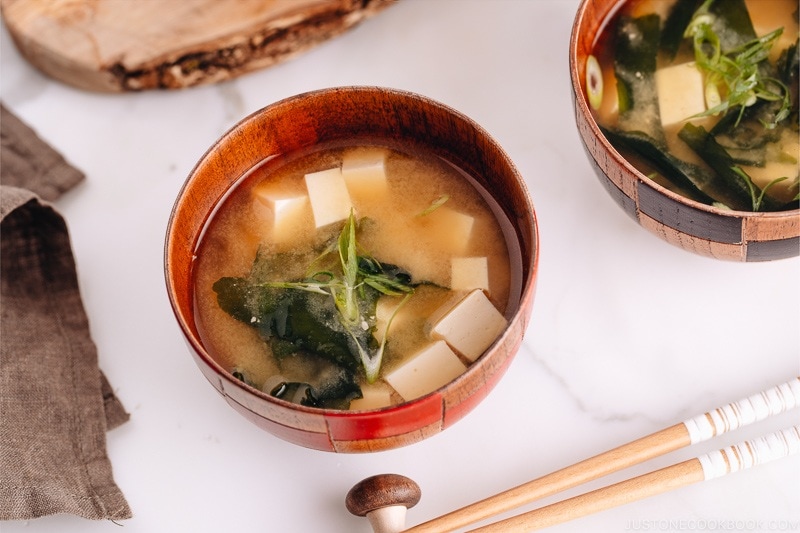
Recipes Using Kombu Dashi
If you can’t access kombu, another delicious option for making another vegetarian/vegan dashi is Shiitake Dashi.
The Ultimate Dashi Guide
Dashi plays an important role as a flavor enhancer in Japanese cooking, so you don’t need to season the food with too much salt, fat, and sugar. Rich in minerals and other vitamins, dashi is considered a healthy ingredient in our daily diet.
There are six different types of dashi you can use in Japanese cooking, including vegetarian and vegan dashi (*).
- Awase Dashi – a stock made from a combination of dried kelp + bonito flakes
- Kombu Dashi * – a stock made from dried kelp
- Katsuo Dashi – a stock made from dried bonito flakes
- Iriko Dashi – a stock made from dried anchovies/sardines
- Shiitake Dashi * – a stock made from dried shiitake mushrooms
- Vegan Dashi * – a stock made from dried shiitake mushrooms and kombu
If you are new to different types of dashi, check out my Ultimate Dashi Guide.
Wish to learn more about Japanese cooking? Sign up for our free newsletter to receive cooking tips & recipe updates! And stay in touch with me on Facebook, Pinterest, YouTube, and Instagram.
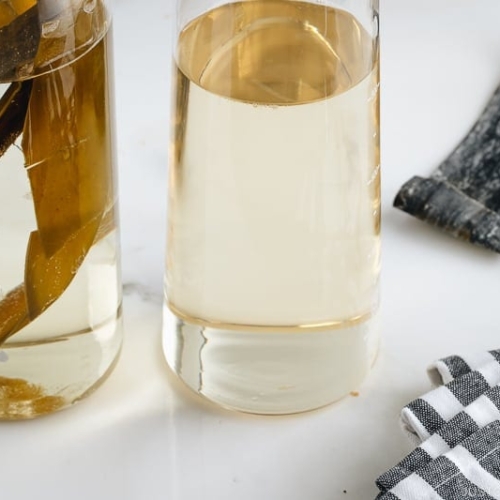
Kombu Dashi (Vegan Dashi)
Video
Ingredients
- 1 piece kombu (dried kelp) (10 g; 4 x 4 inches, 10 x 10 cm per piece)
- 4 cups water
Instructions
- Gather all the ingredients. Most Japanese recipes say to gently clean the kombu with a damp cloth. However, these days, kombu is pretty clean so just make sure it doesn‘t have any mold spots and it‘s ready to use. Do not wash or wipe off the white powdery substance as it has lots of umami.

- Make a couple of slits on 1 piece kombu (dried kelp) to release more flavor.

Method 1: Cold Brew Kombu Dashi (Mizudashi)
- Put 4 cups water and the kombu in a large bottle.

- Put the cap on and let it steep on the counter for 2–3 hours in the summertime and 4–5 hours in the wintertime. You can also cold brew the Kombu Dashi overnight in the refrigerator.

- Remove the kombu from the bottle and reserve the spent kombu (see below). The Kombu Dashi is now ready to use. If you are not using the dashi right away, save it in a bottle and keep in the refrigerator for 4–5 days or in the freezer for 2 weeks. I recommend using it sooner for the best flavor.

Method 2: Kombu Dashi on the Stovetop (Nidashi)
- Put the kombu and water in a medium pot. If you have time, soak for 3 hours or up to a half day. The kombu’s flavor comes out naturally from soaking in water.

- Turn on the heat to medium low and slowly bring to a bare simmer, about 10 minutes.

- Meanwhile, clean the dashi by skimming the foam from the surface with a fine-mesh skimmer.

- Just before the dashi starts boiling, remove the kombu from the pot (see below for what to do with it). If you leave the kombu in the pot, the dashi will become slimy and bitter.

- Now the Kombu Dashi is ready to use.

To Store
- If you are not using the dashi right away, keep it in a bottle or airtight container and store in the refrigerator for 4–5 days or in the freezer for 2 weeks. I recommend using it sooner for the best flavor.
What to do with the spent kombu?
- Save the spent kombu in an airtight container and store it in the refrigerator for a week or in the freezer for up to a month.

- With the spent kombu, you can make Simmered Kombu (Kombu Tsukudani).

- You can also make Homemade Furikake (Rice Seasoning).

Nutrition
Editor’s Note: This post was originally published in February 2013. The images have been updated in April 2019.
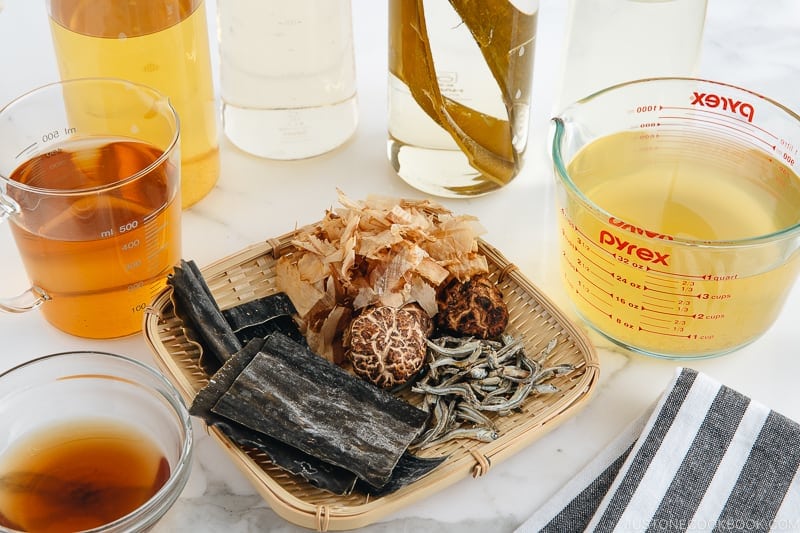
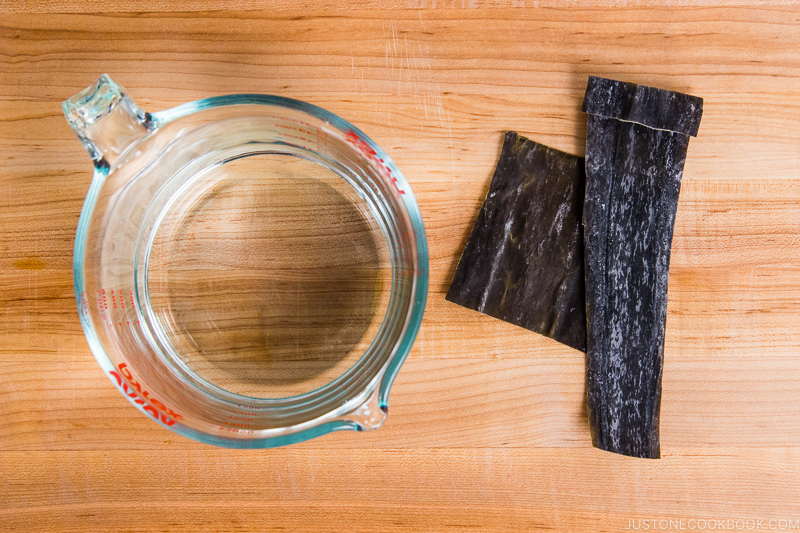
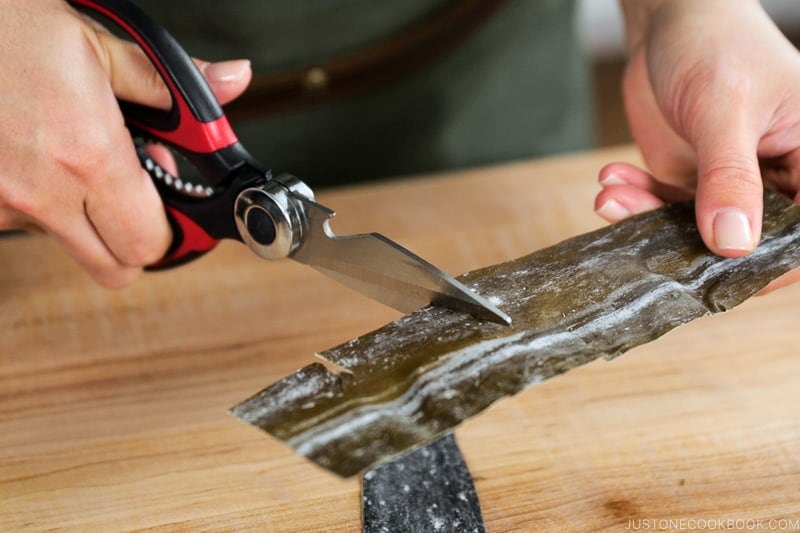
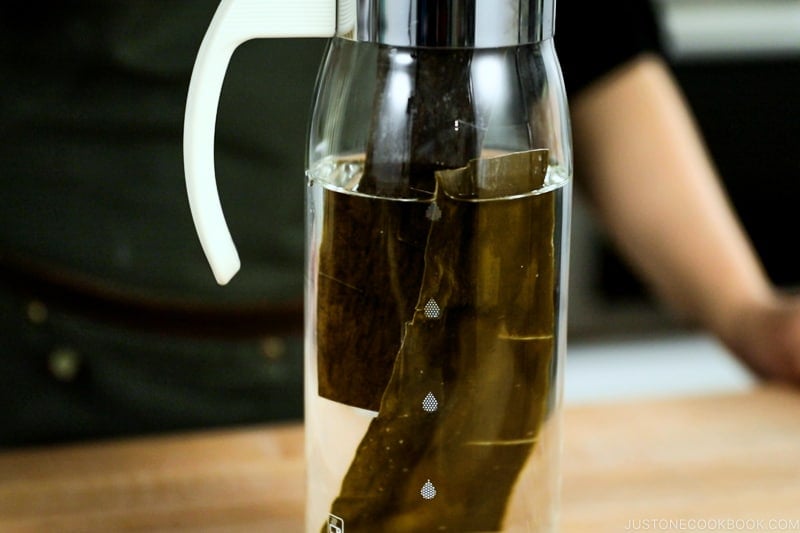
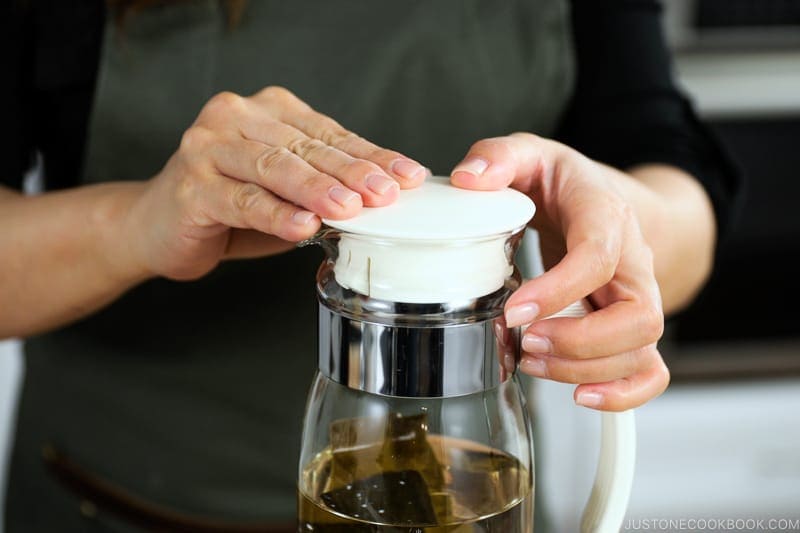
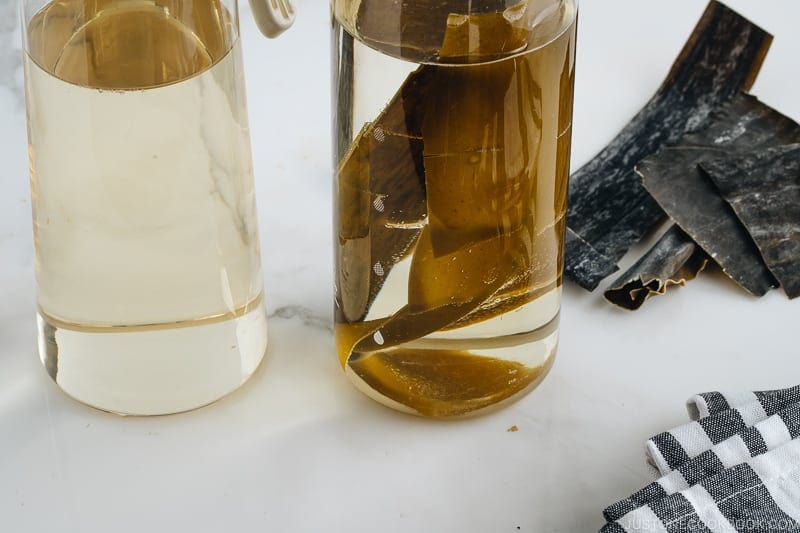
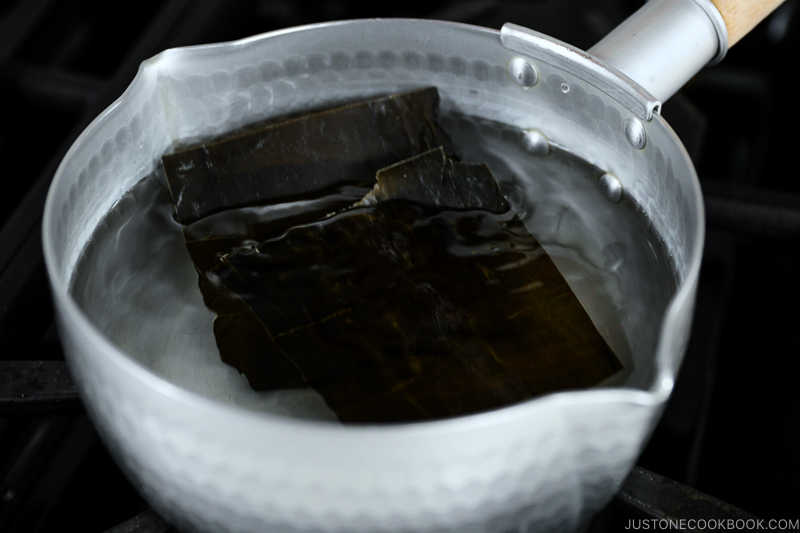
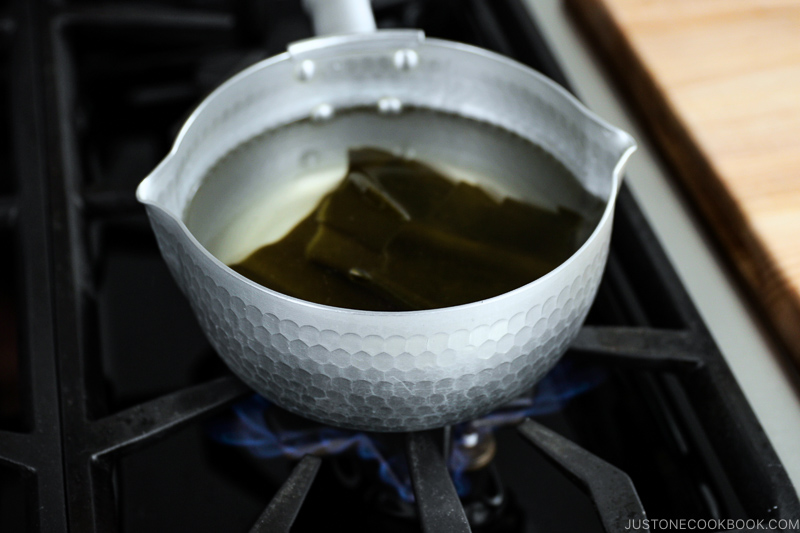
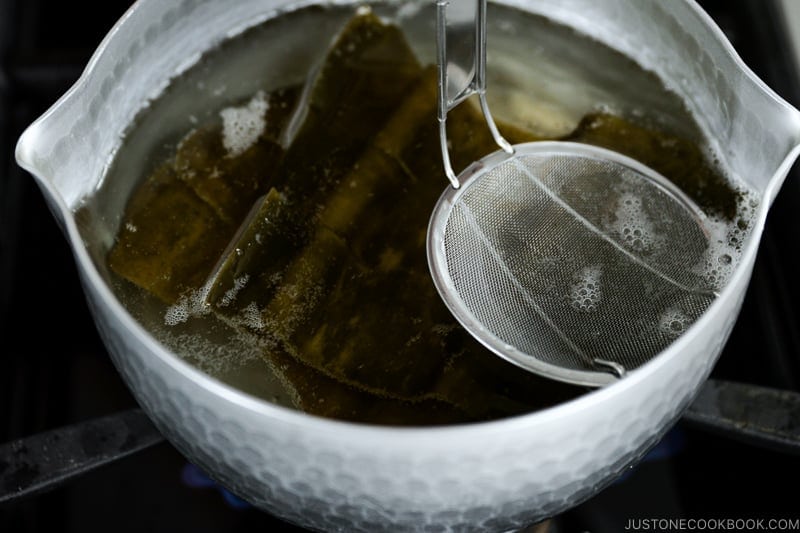
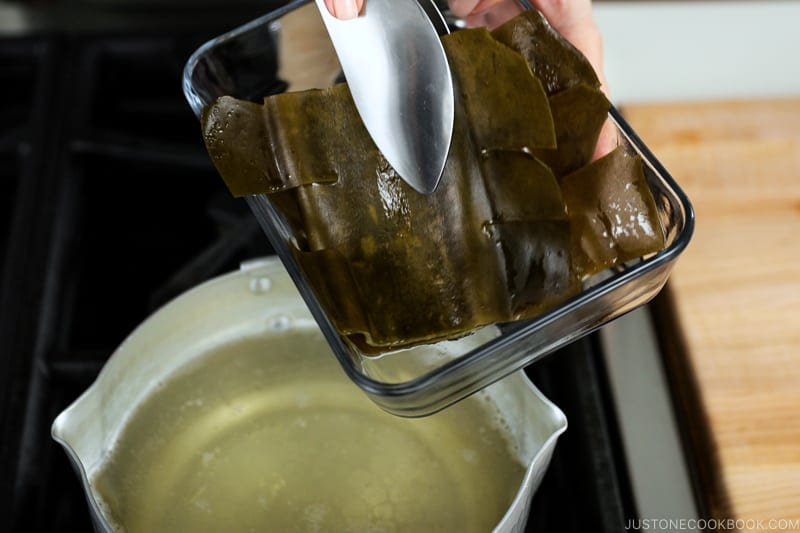
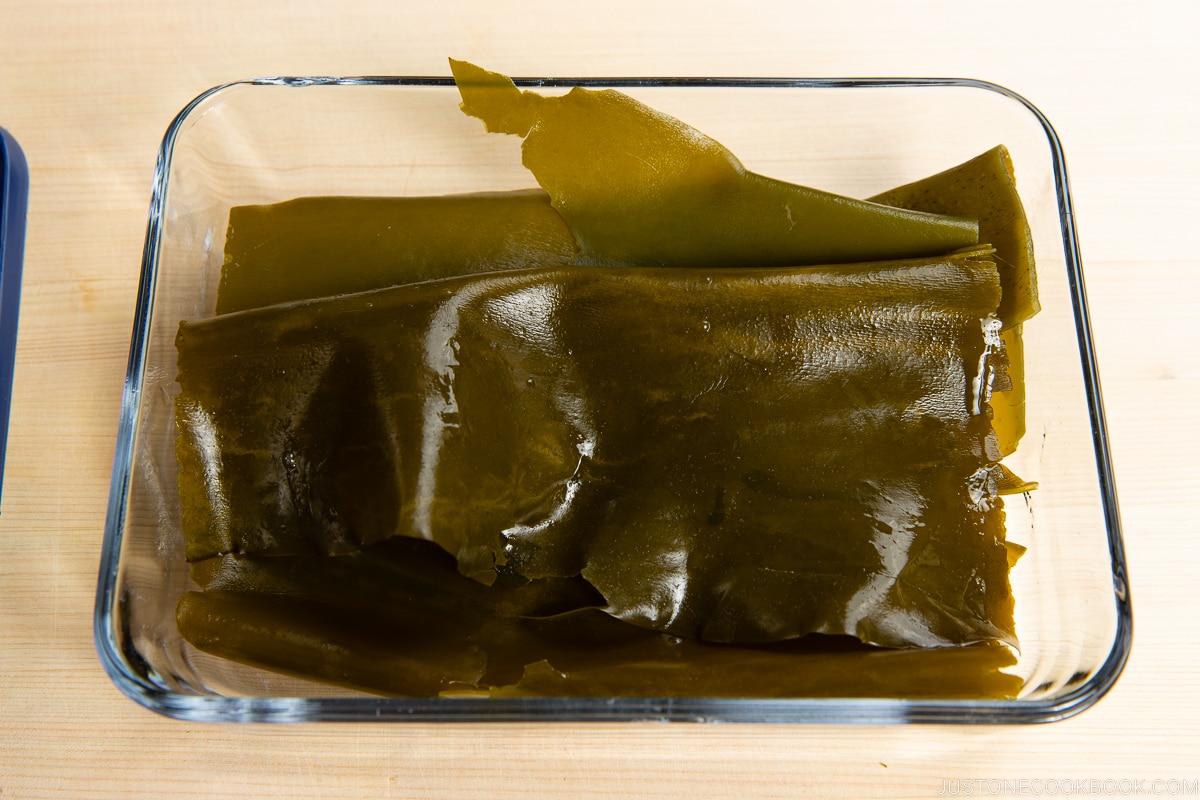
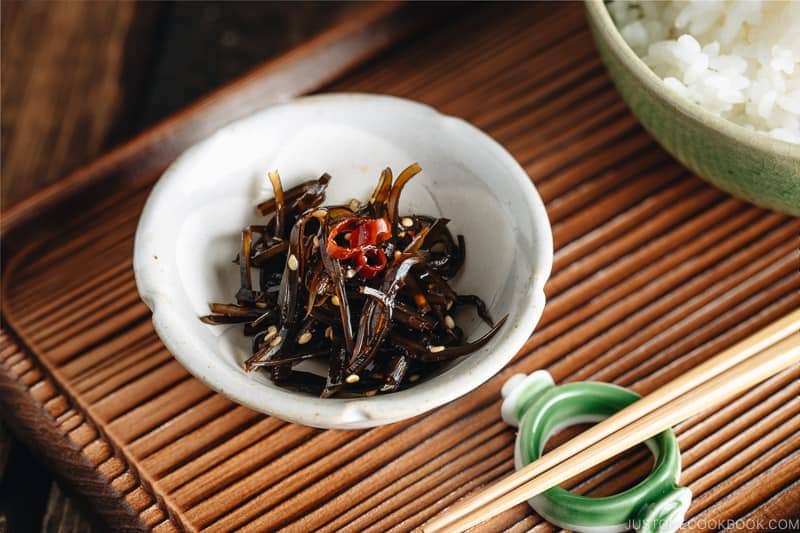
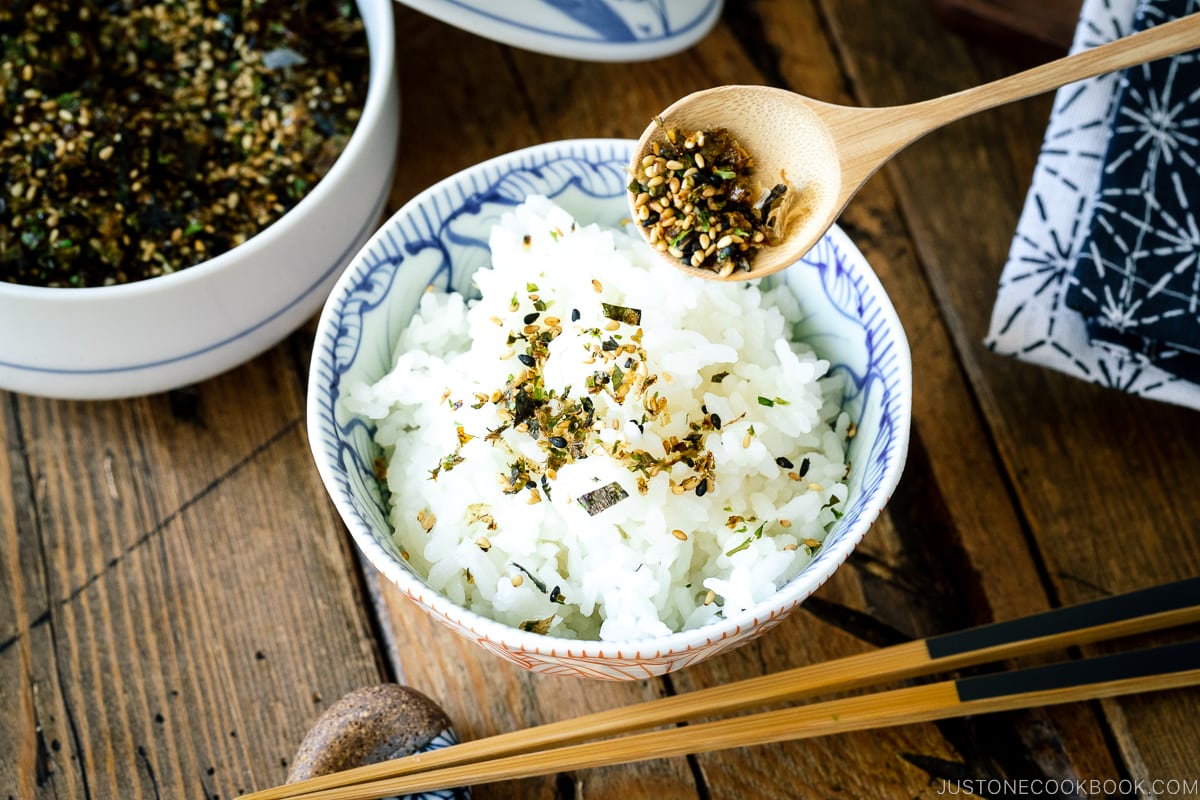










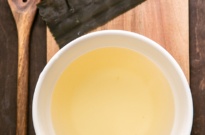
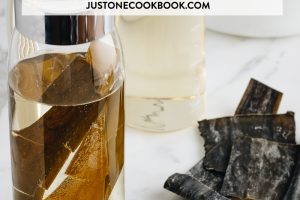
Is it possible to cold brew for too long? I had set mine up for an overnight in my fridge but had forgotten about it for a few days. Would it likely be okay? Or should I start a new brew? Thank you!
Hi Katrina,
Thank you very much for trying this recipe.
The Kombu will start to release too much Alginic acid in the Dashi after 12 hours and result in slimy Dashi. So it may not work as Dashi Stock. 😞
Hi, to make a really think and dense kombu dashi what would you do? I red a factory production system to do it but that’s a hell of a work but in the end you get a clean and pure kombu extract liquid which is very nice, but otherwise how could be possible to get a ekitai kombu dashi nice and dense?
Thank you!
Hi Paolo! I’m not sure how to make it at home except that you make concentrated kombu dashi and strain it… 🙂
Where did you get the two bottles?
Hi Acali! Do you mean these?
https://amzn.to/3eTQs3W (white one)
https://amzn.to/3eLTsiY (red/brown)
Hi Namiko,
I made this dashi via the counter method. I put many pieces of kombu in and I let it sit for about 5 hours. When I took out the kombu pieces, there was slime. I strained the dashi and it seems a little slimy but not too much. What do you think—should I start over, or would you use the dashi?
Many thanks for the recipe and advice!
Lisa
Hi Lisa! The slime for kombu dashi is normal, and you can only avoid it by decreasing the soaking time or using different types of kombu (there are different kinds of kombu – and each one is different how it hydrates). I’d use it, as it’s nothing wrong with it. When I make hot pot dishes, I soak my kombu in my donabe in the morning and leave it for dinner time. 🙂 In summertime (warm weather), I recommend placing the jar in the fridge to keep it safe. 🙂
I am really enjoying your recipes! I did the cold brew method and left the kombu in the refrigerator overnight. This morning it was covered in a gelatinous slime! Is that normal and can I still use the dashi?
Hi Zig! Thank you so much for your kind words! Hmm overnight is usually 8-12 hours, but was yours longer than that?
It depends on the type and quality of kombu too, and some can be softer faster than others, etc. Some kombu can be slimy if you soak for a long time, but overnight (8-12 hours) shouldn’t be too bad. And yes, you can use the kombu and cold brew kombu dashi. I may add more water if the water is too “thick”.
Hello Nami,
thanks for all the great veggie and vegan friendly recipes. I have litte trouble about finding the right amount of kombu to use because the Kombu I bought seems to be very light. 10×10 cm of kombu have a weight of less than 5 g, but in the recipes it is compared to 10g. So should I use as much kombu until it weights about 10g or is 10×10 enough and the weight isn’t that important.
Thanks in advance
Greetings
Leander
Hi Leander! Thank you for your kind feedback. I plan to share more veggie/vegan-friendly recipes in the future as we do have a lot of vegan dishes that are unfamiliar in the world. I would say to follow my weight measurement. There are so many different kinds of kombu and each one has different intensity of flavor. So try making one time and see if you feel it lacks the flavor, then add more. 🙂
[…] all the ingredients. Use Kombu Dashi for a vegan/vegetarian […]
[…] VEGETARIAN/VEGAN-friendly (use Kombu Dashi) […]
[…] version: Use vegan-friendly Kombu Dashi for steeping and garnish with toasted sesame seeds instead of […]
[…] version: Use vegan-friendly Kombu Dashi for steeping and garnish with toasted sesame seeds instead of […]
[…] dashi: You can make your own with kombu and water (here‘s an informative post by Nami of Just One Cookbook) OR use kombu dashi powder if you’re short […]
[…] dashi: you can make your own with kombu and water (here‘s an informative post by Nami of Just One Cookbook) OR use kombu dashi powder if you’re short […]
[…] intéresser. Il remarque alors que la sapidité du bouillon d’algues très populaire au Japon, le kombu dashi , ne correspondait en rien aux saveurs basiques connues jusqu’alors. Ce n’est pas du tout un […]
[…] Kombu: I use cold brew kombu dashi. […]
[…] marinade for several hours. The marinade has umami from dashi (katsuobushi & kombu dashi or vegetarian/vegan dashi), savory taste from soy sauce, and a tinge of sweetness from […]